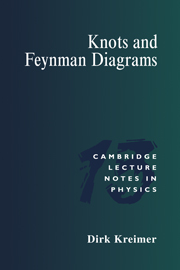Book contents
- Frontmatter
- Contents
- Acknowledgements
- 1 Introduction
- 2 Perturbative quantum field theory
- 3 The Hopf algebra structure of renormalization
- 4 Rationality: no knots, no transcendentals
- 5 The simplest link diagrams
- 6 Necessary topics from knot theory
- 7 Knots to numbers: (2, 2n – 3) torus knots and ζ(2n – 3)
- 8 One-loop words
- 9 Euler–Zagier sums
- 10 Knots and transcendentals
- 11 The four-term relation
- 12 Hopf algebras, non-commutative geometry, and what else?
- References
- Index
2 - Perturbative quantum field theory
Published online by Cambridge University Press: 04 August 2010
- Frontmatter
- Contents
- Acknowledgements
- 1 Introduction
- 2 Perturbative quantum field theory
- 3 The Hopf algebra structure of renormalization
- 4 Rationality: no knots, no transcendentals
- 5 The simplest link diagrams
- 6 Necessary topics from knot theory
- 7 Knots to numbers: (2, 2n – 3) torus knots and ζ(2n – 3)
- 8 One-loop words
- 9 Euler–Zagier sums
- 10 Knots and transcendentals
- 11 The four-term relation
- 12 Hopf algebras, non-commutative geometry, and what else?
- References
- Index
Summary
pQFT
In this chapter we repeat the main steps towards a derivation of the Feynman rules, following the well-known path of canonical quantization. This is standard material, and readers who are not acquainted with such topics are referred to [Bjorken and Drell 1965, Bogoliubov and Shirkov 1980, Itzykson and Zuber 1980, Kaku 1993, Weinberg 1995, Peskin and Schroeder 1995, Teller 1997]. We hope that the short summary given here, similar to that in [Kreimer 1997a], is helpful for readers who want to refresh their memory.
Having introduced Feynman rules, we next introduce Schwinger–Dyson equations as a motivation for the introduction of Z-factors. We remark on dimensional regularization and give a short expository overview of the basic notions of renormalization, again meant to be a reminder more than a thorough exposition, which, whenever necessary, can be found in the literature on the subject [Bogoliubov and Shirkov 1980, Collins 1984].
As far as our notation and conventions are concerned, we follow [Kaku 1993, Kreimer 1997a].
Canonical quantization
Free propagating particles are specified by various types of lines (propagators) and interact at vertices, points in spacetime where three or more lines merge together. These vertices describe the coupling of particles, and are specified by a coupling constant which determines the strength of the interaction at the vertex. In this way, each graph built out of propagators and vertices describes a process in pQFT.
- Type
- Chapter
- Information
- Knots and Feynman Diagrams , pp. 7 - 35Publisher: Cambridge University PressPrint publication year: 2000



